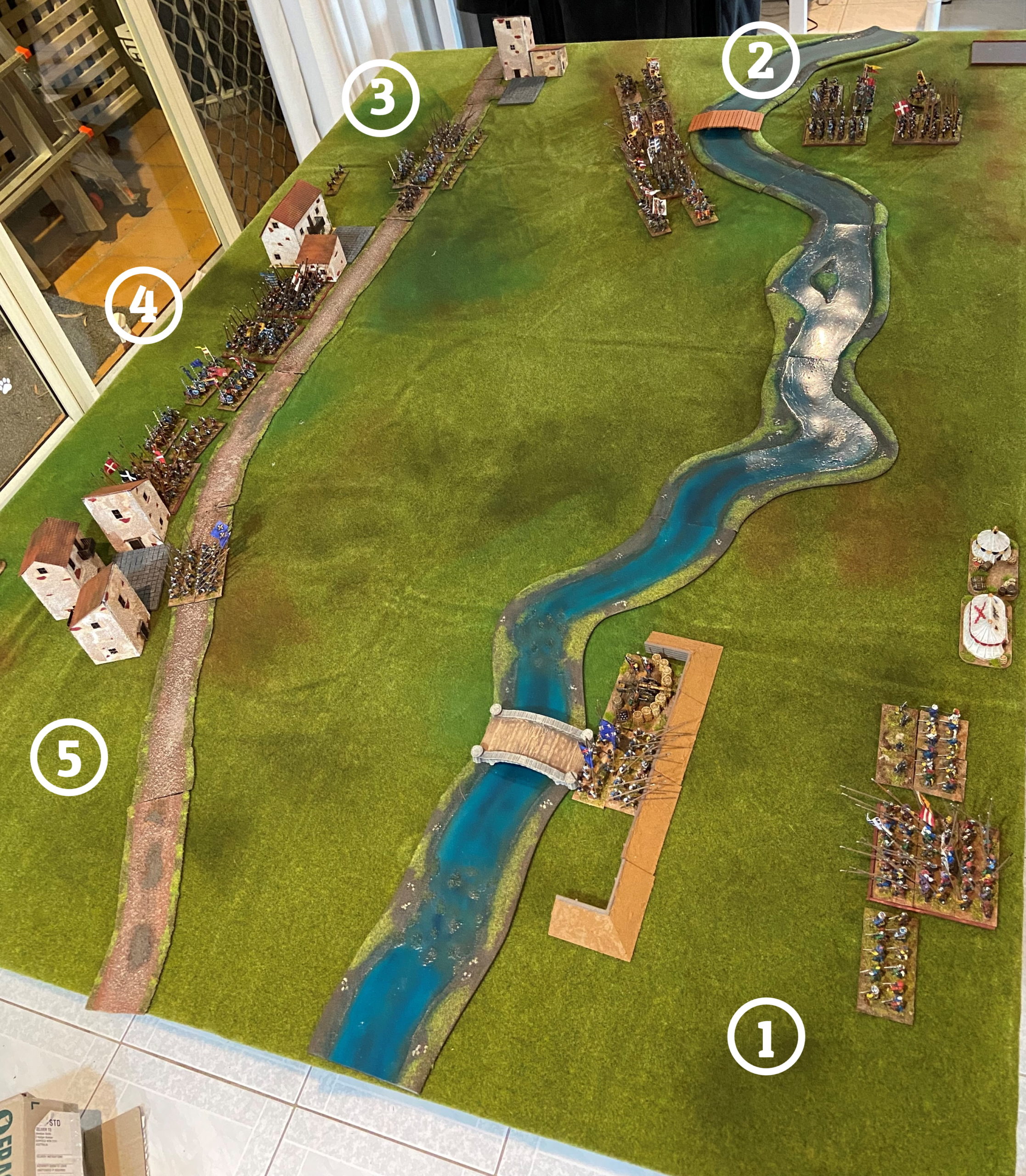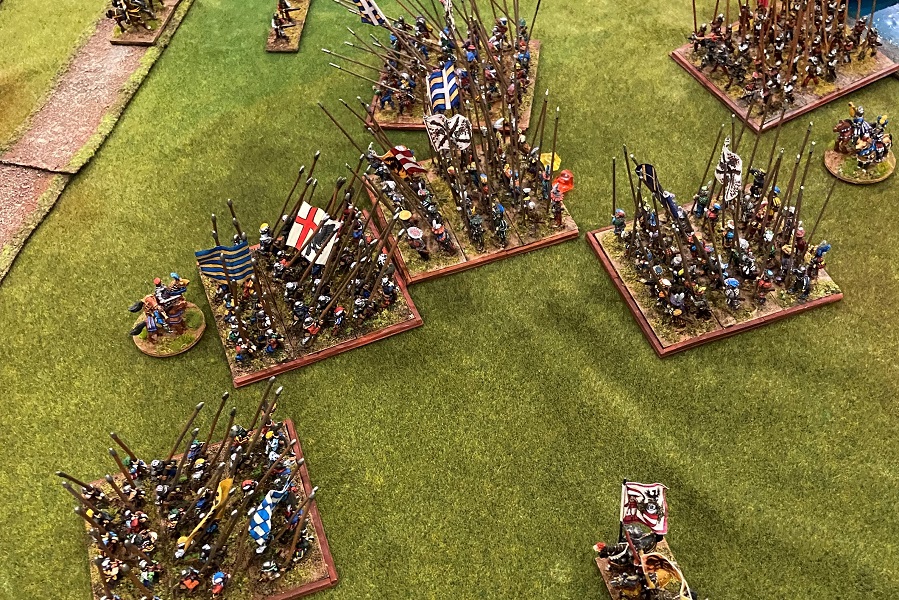
I have wanted to play the Battle of Garigliano for a while. Like many wargamers who are interested in the Italian wars I’ve looked at James Roach’s “Olicanalad” blog and admired his battle reports which always serve to showcase his very nice armies on an even nicer giant table. His Garigliano reports particularly appealed to me as I’m a sucker for anything with a lot of towns on the table and a really big river.
Most of my games are played on a Wednesday evening at the local club but on the first Saturday of each month the “Company of Dice” club has a big space and its a good venue to put on a game that’s too big to set up and pack up in an evening session.
One obstacle to doing Garigliano was not actually having a Spanish army. While I have jinettes and Spanish shot I don’t actually have any Spanish colunella. The Spanish would be played by an Imperial army and bring landsknechts to the table instead.
My original plan was to put on Garigliano using Warlord’s Pike & Shotte rules and do it as a two player game. My opponent is a huge Sword & Spear fan but owed me a game of my choice. Due to circumstances the game got crashed by a third player, also a huge Sword & Spear fan and with #strongopinions about Pike & Shotte. Thus outnumbered and not wanting to spend a whole day hearing about how the game would have been better if we’d played Sword & Spear instead I decided to give the people what they want and make it a Sword and Spear game.
Making a scenario for Sword and Spear
Garigliano is quite different to a lot of other battles or the period. The big flanking manoeuvre that opens the battle sets some interesting challenges to both players. Can the Spanish capitalise on their element of surprise and roll up the French before the French numerical advantage kicks in? Can the French mobilise and deploy quickly enough to face the threat and how much should they commit to defend their bridgehead and prevent an end-run to Trajetto?
I spent some time the night before laying out the terrain and troops to make sure everything ‘fit’ and that the starting distances between troops were about right and thought about the house rules needed for Sword and Spear to make the scenario work. Here’s the layout that I ended up with.


- The French bridgehead (with a gap for an additional crossbow unit)
- The pontoon bridge, crossing force and reserve
- The French forces around Sujo
- The French forces between Castelforte and San Cosmo
- The French forces at Trajetto
There were a few things to think about when designing a scenario for Garigliano:
- The French need to have a delay in activating to represent the surprise of the attack and their disorganisation on the day
- The scenario needs flexibility of movement as both sides have to swing out in a big arc – the Spanish swinging to the right from their pontoon bridge and the French swinging out to their left as they ‘wake up’ from their starting positions
- The Spanish need to clear a series of towns on their way to the left, starting with Sujo which is closest to their pontoon bridge and the French are encamped in and around these towns at start
- Finally, the distances involved need to fit the ruleset as its a longways slog up the table, especially for any French reserves
Delaying the French – Sword and Spear has a bag of dice with colours for each side. You pull a handful of dice and give each player their colour. The players then roll them and assign the rolled dice to the units that can use them. To delay the French build-up I decided that the French should only have dice in the bag for their units at Sujo and the French bridgehead (numbers 1, and 3 in the pictures below). The dice for the units around San Cosmo and Castelforte would be added from turn three onwards, and the dice for the units at Trajetto would be added at turn four. The French player would be able to allocate their dice to any unit but until its dice had been added they would need one higher discipline to activate. For instance, the Swiss at Castelforte would normally need a 4 to activate, but would need a 5 to activate during turns one and two.
Freeing up movement – Sword and Spear has its roots as a game for classical armies facing each other across an open plane. The rules don’t allow wheeling. Manoeuvring is difficult. Group moves must be made by groups in edge to edge contact, and even then only straight ahead. None of this was conducive to the complexity of crossing a bridge, fanning out, and arcing around to roll up the table.
I introduced some house rules to address this. Firstly the pontoon bridge wouldn’t actually be moved over. Units could teleport over it from reserve using a manoeuvre order and end with some part of their base touching it. This would prevent needing two or three turns to shuffle into place and over it. The French would receive a similar advantage to come out of reserve. Their first activation would be involve placing themselves with some part of their base touching the road, at any angle and move out from there. This would help them to appear facing the attacker without having to immediately worry about being flanked.
Finally, since there would be very few units in a contiguous line I changed the rule for group moves to allow it to be made by units which had both a 1DU gap between them and without requiring their front edges to be aligned. This meant that an echelon of units 1DU apart could all be given a group order. This would help the Spanish with their attack and the French to bring up reserve units.
Positioning the towns and French reserve – I elected to fudge the town placement a bit for the sake of the game. Sword and Spear doesn’t have any rules for fighting in built up areas. The closest would be to call them ‘difficult terrain’ like rocks or scrub and that didn’t feel right. Sujo is closer to the pontoon bridge and if we were playing Pike & Shotte I would probably have left it closer in, and garrisoned, but I decided that for Sword and Spear it wasn’t worth trying to come up with rules for fighting in a town so I pushed it back into the corner and assumed the Spanish had cleared it by virtue of showing up.
I decided to treat the road itself as a reserve area. Effectively anything behind the road would not be in play and units would come into play from the French reserve touching the road with some part of their base. This meant that the exact positioning of the reserve units was less critical.
Finally I merged the towns of San Cosmo and Castelforte into one representation at the middle of the French position.
Winning the towns would be solved by general argument and pointing rather than a specific rule. I was hoping it would turn out to be clear enough who had what.
How it played


The Spanish attack from the pontoon bridge gets off to a slow start, their shot and gendarmes advancing cautiously in front of the French who refuse to be drawn from their starting positions. The French crossbow manoeuvre to weaken the Spanish gendarmes with fire from their flank, and the Spanish jinettes in turn move to flank the crossbow.
Meanwhile the French player uses the dice generated by the French defenders at Sujo to begin to activate the Swiss pike blocks and bring them forwards to face the landsknechts causing the Spanish player to shift their landsknechts to the left and bring more reserves across the pontoon bridge.

Meanwhile the attack on the French bridgehead combat begins with a shooting exchange. The Spanish launch an attack which gets off to an inauspicious start as the rodoleros get defeated in melee by the French artillery – twice!


The Swiss pike get to grips with the Landsknechts in a to-and-fro contest in the center. The French player continues to prioritise activating his reserves and the Spanish prefer to build up slowly, advancing only far enough to free up space to bring their reserves over the pontoon bridge. The French and Spanish gendarmes face off on the flank of the main pike battle.
On the French far left the Spanish jinettes get drawn into a protracted ineffective combat with the French crossbow, but at least draw their shooting away from the Spanish gendarmes who launch an attack at the weakened French infantry, supported by shooting.

At the French bridgehead, the Spanish finally shoot away the defending French crossbow and the rodoleros eventually defeat the artillery in melee. The landsknechts launch their attack against the defending French infantry.


The French defenders at Sujo, meant to be little more than a speed bump, put up a gallant defense, routing the Spanish gendarmes. The Spanish player brings up one of his units of landsknechts from reserve and sweeps away the French skirmish screen, pursuing through into the French gendarmes standing in reserve and routing them in turn.
In the centre the Swiss and landsknechts continue to exchange blows. Poor rolling from the landsknechts sees their numerical advantage slowly become overwhelmed by the Swiss as the battle begins to turn the French player’s way.
The clash of gendarmes finally happens – though unfortunately not photographed – which also goes the French player’s way.
The high watermark for the Spanish is to finally defeat the remaining French forces at the French bridgehead and position themselves at the bridge ready to cross towards Trajetto. Unfortunately, the rest of the Spanish attack has failed and there are no forces to link up with.
At this point we called the battle. Despite Spanish attempts to claim a draw based on casualties, they had failed to match history and so it was awarded as a win to the French.
Conclusion
Overall the scenario worked very well though with some unexpected deviations from the design. The intention was that the French would be engaged at Sujo, quicly overwhelmed and then the Spanish would begin to achieve an advantage in number of remaning activation dice as they removed French units. They would then push the attack towards the French, rolling up towards the Trajetto.
Instead, the French player decided to not allocate any command dice to their ‘at-start’ force and hold them back. Since the Spanish also didn’t move to engage them aggressively as expected, there was no downside to this for the French player and they were free to use their limited dice to accelerate bringing the Swiss in to play from the reserve. This was a completely valid way to play the scenario as presented, though next time I would probably position the French a bit closer to the Spanish to force the engagement and make it more difficult to prematurely bring up the reserve.
The other house rules for manoeuvring, bridge crossing, and activation from reserve all worked well and helped the units to get into contact in good time.

Leave a Reply